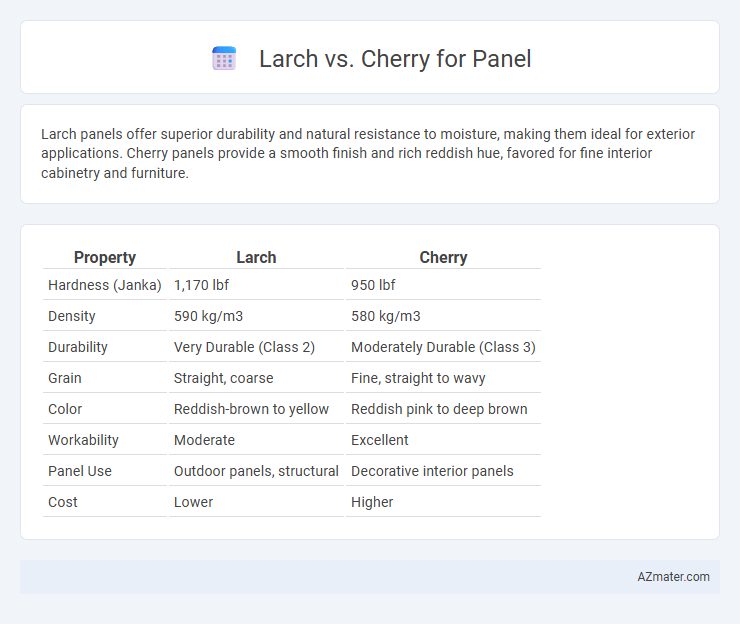Larch panels offer superior durability and natural resistance to moisture, making them ideal for exterior applications. Cherry panels provide a smooth finish and rich reddish hue, favored for fine interior cabinetry and furniture.
Table of Comparison
| Property | Larch | Cherry |
|---|---|---|
| Hardness (Janka) | 1,170 lbf | 950 lbf |
| Density | 590 kg/m3 | 580 kg/m3 |
| Durability | Very Durable (Class 2) | Moderately Durable (Class 3) |
| Grain | Straight, coarse | Fine, straight to wavy |
| Color | Reddish-brown to yellow | Reddish pink to deep brown |
| Workability | Moderate | Excellent |
| Panel Use | Outdoor panels, structural | Decorative interior panels |
| Cost | Lower | Higher |
Introduction: Comparing Larch and Cherry for Paneling
Larch wood offers exceptional durability and natural resistance to moisture, making it ideal for paneling in environments prone to humidity. Cherry wood boasts a rich, warm color and smooth grain that enhances interior aesthetics, favored for decorative paneling where visual appeal is paramount. Choosing between Larch and Cherry for paneling depends on balancing functional durability with desired visual characteristics.
Wood Characteristics: Larch vs Cherry
Larch wood is known for its exceptional durability, high resin content, and resistance to moisture, making it ideal for exterior panels and heavy-duty applications. Cherry wood, prized for its smooth texture, fine grain, and rich reddish-brown color, excels in interior paneling where aesthetic appeal and ease of finishing are paramount. While larch offers superior strength and weather resistance, cherry provides a warmer tone and better workability for detailed craftsmanship.
Color and Grain Patterns
Larch wood features a warm, honey-golden tone with pronounced reddish undertones that darken over time, creating a dynamic and rustic aesthetic for paneling. Cherry wood exhibits rich, reddish-brown hues that deepen to a lustrous, mahogany shade with age, offering a luxurious and classic appearance. Grain patterns in larch are typically straight with visible resin canals and knots, contributing to a rugged character, whereas cherry displays smooth, fine, and consistent grain lines that enhance its elegant and refined look.
Durability and Hardness
Larch wood offers superior durability and natural resistance to rot and decay, making it ideal for exterior and high-moisture panel applications. Cherry, while valued for its aesthetic appeal and fine grain, is softer and less resistant to wear and impact compared to Larch. For paneling that demands long-lasting hardness and resilience, Larch outperforms Cherry significantly in maintaining structural integrity over time.
Workability and Machinability
Larch wood offers moderate machinability with its coarse texture, requiring sharp tools for smooth finishes, while cherry wood excels due to its fine, even grain and consistent density, allowing for precise cuts and smoother surfaces. Workability of larch is generally good for panel applications but demands careful handling to avoid splintering; cherry's superior workability makes it preferred for intricate detailing and fine joinery. Both woods respond well to sanding and finishing, but cherry often provides a richer final appearance due to its naturally smooth texture and color consistency.
Resistance to Moisture and Decay
Larch wood exhibits superior resistance to moisture and decay compared to cherry, making it an ideal choice for panels exposed to damp or outdoor environments. Its high resin content and natural durability provide excellent protection against fungal attacks and rot. Cherry, while visually appealing with its rich color and smooth grain, is less resilient to moisture and requires proper sealing to prevent decay over time.
Cost Comparison: Larch vs Cherry Panels
Larch panels typically offer a more budget-friendly option compared to cherry panels, with prices averaging 30-50% lower due to larch's faster growth and greater availability. Cherry panels command a premium price because of their rich color, fine grain, and durability, often costing between $15 to $30 per square foot, while larch panels range from $8 to $15 per square foot. Choosing larch provides cost savings without sacrificing structural integrity, whereas cherry is preferred for high-end applications where aesthetic value justifies the higher investment.
Aesthetic Appeal and Design Versatility
Larch wood offers a distinctive reddish-brown hue with prominent grain patterns that enhance rustic or natural aesthetics in paneling. Cherry wood provides a rich, warm tone that deepens over time, creating elegant and timeless panels suitable for classic and contemporary designs. The smoother texture and finer grain of cherry allow greater design versatility, accommodating intricate carvings and varied finishes compared to the more rugged character of larch.
Sustainability and Environmental Impact
Larch wood is a highly sustainable option for paneling due to its rapid growth rate and natural resistance to decay, reducing the need for chemical treatments. Cherry wood, while prized for its rich color and fine grain, has a slower growth cycle, which can contribute to higher environmental impact through longer harvesting periods. Choosing larch over cherry for panels supports lower carbon footprints and promotes responsible forestry practices by enabling quicker reforestation and reduced habitat disruption.
Best Applications: Choosing Between Larch and Cherry for Panels
Larch wood, known for its durability and natural resistance to moisture, is ideal for exterior paneling and applications requiring weather resistance. Cherry wood offers a smooth texture and rich reddish hue, making it perfect for interior panels where aesthetics and fine finishes are prioritized. Selecting between larch and cherry for panels depends on environmental exposure and desired visual appeal, with larch suited for outdoor use and cherry favored for decorative indoor surfaces.

Infographic: Larch vs Cherry for Panel
 azmater.com
azmater.com